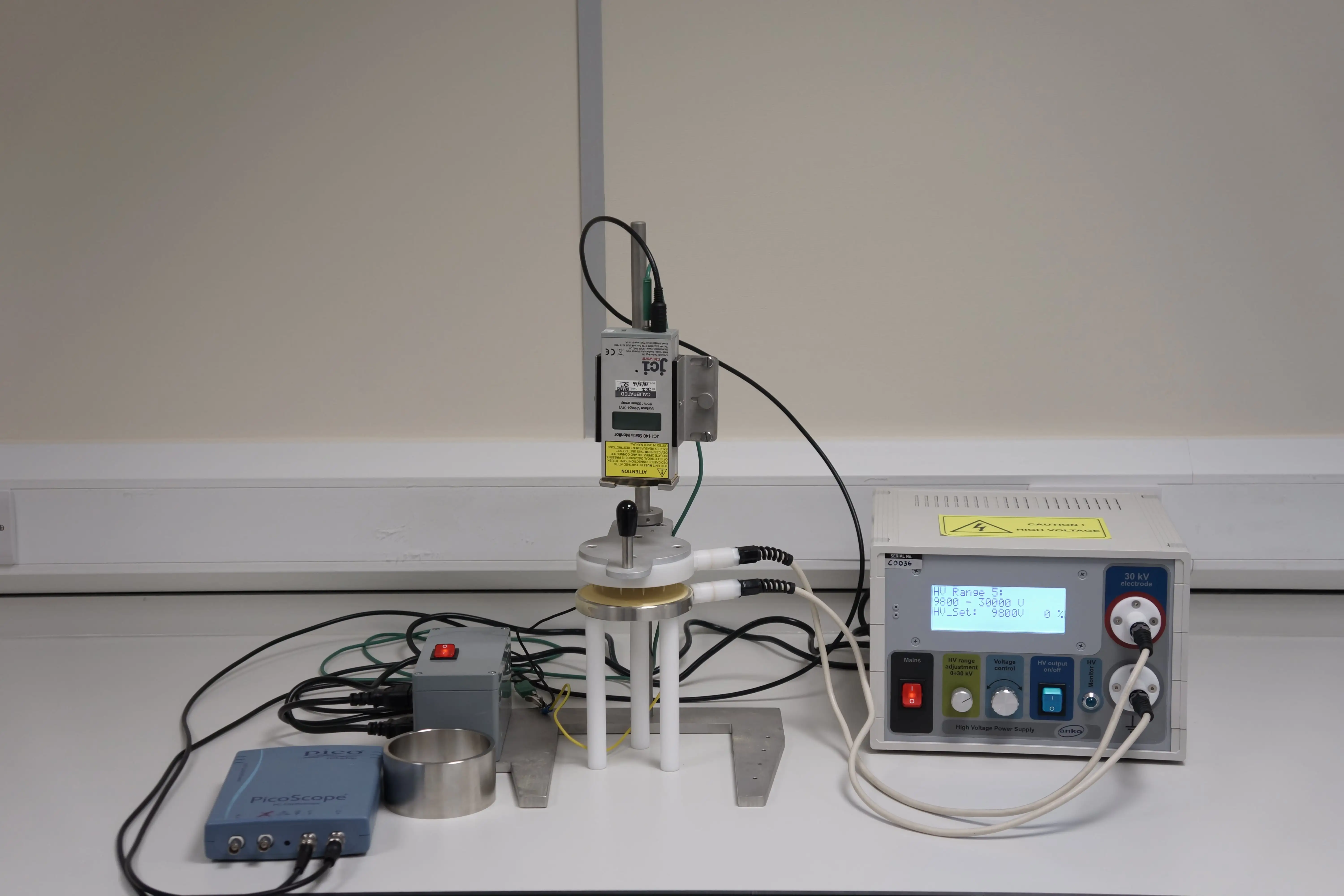Our laboratories generate electrostatic discharge test data on a range of potential material hazards that are present across the process industry.
-
Powder Volume Resistivity
-
Liquid Conductivity
-
Surface Resistivity
-
Volume Resistivity
-
Powder Charge Relaxation Time
Please contact us if you have any bespoke electrostatic testing requirements, or if you require consultancy services related to electrostatic safety.
Electrostatic discharge is a hazardous threat to your processing systems, business, workplace and people. With the potential risk for both fire and explosions, electrostatic discharge can add complications to your operations.
Sigma-HSE’s electrostatic testing lab offers comprehensive standard and custom testing packages to aid you in identifying and reducing electrostatic hazards and other risks associated with your hazardous materials.
Test the potential for electrostatic discharge
The Sigma-HSE Advantage
Request a Free Technical Consultation
Discover our range of electrostatic discharge testing solutions
POWDER VOLUME RESISTIVITY
Standards
BS EN ISO IEC 80079-20-2 / BS EN 60079-32-2: 2015 / PD CLC TR 60079-32-1
Test
The test is conducted by passing a predetermined voltage between two electrodes of known geometric size through a test material of known volume, under the control of the specific test conditions. Generally, direct resistance is measured, and the resistivity is calculated.
Many materials’ surfaces absorb atmospheric moisture or attract it to the surface of their particles. The addition or removal of this moisture often has a marked effect on the resistivity of the material. Therefore, preconditioning and testing are typically performed under controlled relative humidity conditions of 25 (± 5) % and 23 (± 2) °C.
The test classifies a material using the following standardised boundaries:
As per BS EN ISO / IEC 80079-20-2: 2016 Explosive atmospheres Part 20-2: Material characteristics – Combustible dust test methods, powders may be grouped according to their resistivity as follows:
- A resistivity of 1 × 103 Ω·m or less shall be a Group IIIC conductive dust.
- A resistivity greater than 1 × 103 Ω·m shall be a Group IIIB non-conductive dust.
As per PD CLC TR 60079-32-1:2018 – Explosive atmospheres. Electrostatic hazards guidance, powders may be grouped according to their resistivity as follows:
- low resistivity powders, with volume resistivity’s ρ ≤ 1 MΩ m;
- medium resistivity powders, with volume resistivity’s 1 MΩ m < ρ ≤ 10 GΩ m;
- high resistivity powders, with resistivity’s ρ > 10 GΩ m.
Benefits
The volume resistivity of a powder dictates how efficiently charge migrate through a material by electrical conduction. The higher the volume resistivity value, the more resistive the powder is. High resistivity powders will accumulate and retain charge presented to them in all situations.
Low and most mid-range resistivity materials (conductive and static dissipative) will dissipate charge, providing it has a good path to earth. This process can be achieved by handling these powders in a well earthed environment (earthed conductive or static electricity dissipative containers, silos, hoppers, tools and plant equipment).
The build-up and retention of charge on a powder, object or equipment possess the biggest threat if the charge is suddenly released in the form of a spark discharge, which can cause an ignition of a flammable atmosphere. Therefore, it is imperative to know and understand the electrostatic properties of your powders to ensure they are handled correctly to prevent discharges and potential ignition of flammable atmospheres.
LIQUID CONDUCTIVITY
Standards
BS EN 60079-32-2
Test
The liquid conductivity test is conducted to establish whether a liquid will allow an electrical charge to migrate through it or not and therefore evaluate its ability to accumulate and retain a charge.
The liquid to be tested is slowly charged into a cylindrical, measuring test cell comprising of an inner pole and a concentric outer electrode. A voltage is applied, and the current is measured from one electrode to the other. Using the current value measured, a liquid conductivity is calculated using the test cells constant, determined from its geometry.
The test classifies a material using the following standardised boundaries:
The level of charge accumulation in a particular liquid, and therefore the electrostatic hazard that static electricity can be created, is strongly dependent upon its electrical conductivity and dielectric constant (relative permittivity), εr. To describe the possible hazards and associated means of prevention. As per PD IEC/TS 60079-32-1:2018 – Explosive atmospheres. Electrostatic hazards guidance, liquids may be classified according to their conductivity as follows:
- high conductivity > 10 000 pS/m;
- medium conductivity between 25 × εr pS/m and 10 000 pS/m;
- low conductivity < 25 × εr pS/m.
For liquids with a dielectric constant of around 2, (e.g. hydrocarbons), these classifications reduce to:
- high conductivity > 10 000 pS/m;
- medium conductivity between 50 pS/m and 10 000 pS/m;
- low conductivity < 50 pS/m.
For liquids with a dielectric constant that is substantially higher than 2 or for liquids whose dielectric constant is unknown, the border limit for low conductivity is usually set to 100 pS/m. The upper border limit of medium conductivity remains at 10 000 pS/m.
Benefits
The test allows for correct handling and manufacturing procedures to be established. A material with a low conductivity would be considered insulating and therefore stop the migration of charge. With a charging mechanism present, the accumulation of potentially hazardous levels of charge may occur.
The conductivity dictates how efficiently charge migrate through a material by electrical conduction. The lower the conductivity value, the more resistive the liquid is. Low conductivity liquids will accumulate and retain charge presented to it in all situations. Most high and mid-range conductivity materials (conductive and static dissipative) will dissipate charge, providing it has a good path to earth. This can be achieved by handling these liquids in a well earthed environment (earthed conductive or static dissipative containers and plant equipment). The build-up and retention of charge on liquid or equipment (conductive or insulating) creates a hazard if the charge is suddenly released in the form of a discharge which can cause an ignition of a flammable atmosphere. Many solvents have extremely low minimum ignition energies, meaning most types of electrostatic discharges will ignite their vapours.
SURFACE RESISTIVITY
Standards
BS EN 61340-2-3 / BS EN 1149-1
Test
Surface resistivity is a calculated value based on the measured surface resistance using a test cell with known geometry. It is an inherent property of the surface of a material and is independent of sample surface area. Testing is conducted by applying a range of voltages from one electrode in intimate contact with the specimen’s surface and measuring either a current or direct resistance across the surface to a second electrode.
The values of either measured or calculated resistance are multiplied by a cell constant, generated from the test cell’s geometric size and configuration to derive a Surface Resistivity value. The unit of surface resistivity is the ohm, however, to differentiate between surface resistance (dependent on sample size) and surface resistivity, often the value is displayed in Ohms per Square (Ω/□).
Humidity can affect this parameter or characteristic, so testing is performed in controlled environmental conditions.
Benefits
The test can be used to ensure that materials intended to promote sufficient electrical connection to avoid charge accumulation are in line with the standards guidance on resistivity boundaries. Often materials advertised as such fall short of the mark, so its always wise to get this checked before committing to a large order that may jeopardise safety, where having a dissipative material is intrinsic to ensuring low charge levels or sufficient electrical connection.
VOLUME RESISTIVITY
Standards
BS EN 61340-2-3 / BS EN 1149-2
Test
Volume resistivity is a calculated value based on the measured volume resistance using a test cell with known geometry. It is an inherent property of a material and is independent of sample thickness. Testing is conducted by applying a range of voltages from one electrode in intimate direct contact, with one of the specimen’s surfaces and measuring either a current or direct resistance through the material to a second electrode on the opposing surface.
The values of either measured or calculated resistance are equated with a cell constant, generated from the test cells’ geometric size and the thickness of the tested material, to derive a volume resistivity value. The unit of volume resistivity is Ohm Meters (Ωm).
Humidity can affect this parameter or characteristic, so testing is performed in controlled environmental conditions.
The test is predominantly conducted on liners, hoses, sheet materials and laminates (BS EN 61340-2-3 “Methods of test for determining the resistance and resistivity of solid planar materials to avoid electrostatic charge accumulation”) or items of clothing / personal protective equipment (PPE) (EN 1149-1 “Protective clothing – Electrostatic properties – Part 2: Test method for measurement of the electrical resistance through a material (vertical resistance)”).
Benefits
The test can be used to ensure that materials intended to promote sufficient electrical connection to avoid charge accumulation are in line with the standards guidance on resistivity boundaries. Often materials advertised as such fall short of the mark, so its always wise to get this checked before committing to a large order that may jeopardise safety, where having a dissipative material is intrinsic to ensuring low charge levels or sufficient electrical connection.
POWDER CHARGE RELAXATION TIME
Standards
BS 7506 & BS 5958
Test
The material to be tested is placed into an earthed stainless steel sample cup and using corona charging the sample is sprayed with a potential of approximately 10 kV. The charging plate is retracted, revealing the charged material to the field meter and the acquisition system process is automatically initiated.
The sample voltage is monitored and recorded by the electrostatic field meter, and voltage versus time is graphically displayed using the acquisition software connected to the field meter output.
Benefits
Charge relaxation time or charge decay constant is a very good indication of a material’s ability or failure to self-dissipate energy or static charge.
A dissipative material will allow energy or charge to migrate over its surface and/or through its volume in a time that is short compared to an insulating material, for example, which will exhibit a long undesirable charge relaxation time.

